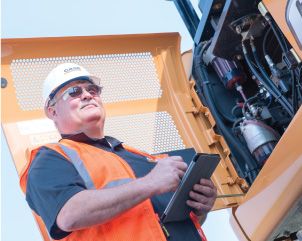Best Practices
Operator Safety
Follow these guidelines to help reduce injuries due to operator error. Contact the location nearest you for all your safety equipment needs.
Check pins and bushings – Pins and bushings can loosen over time, causing a safety hazard. Establish a maintenance routine which includes checking, tightening and replacing pins and bushings.
Maintain 3 points of contact – Getting in and out of machines is the number one cause of injury. Insure you always have 3 points of contact with the machine while climbing into or out of the machine.
Know your surroundings – Check your mirrors and use a spotter, if necessary, to stay centered on ramps.
Rope off your swing radius – Use a spotter to help rope off the swing radius of your machine and keep bystanders out of harm’s way.
Know the limits of your machine – Machines can tip over, even on level ground. Know your machine’s capabilities. Just because you made it up a slope, doesn’t mean you can make it back down.
Mark overhead or underground hazards – When digging, be sure to mark all hazards and proceed with caution. When working above ground, identify all potential hazards overhead.
Travel in reverse with caution – Use wide angle mirrors, and adjust them whenever you begin operation to minimize blind spots. Always be aware of the machine’s perimeter, stepping out of the cab to view surroundings, if necessary.
Always strap in – Always use a seat belt or harness, even when the cab is closed. Use the proper machine – Avoid using machines for functions they weren’t designed to do, especially lifting functions.
Lock-out/tag-out – Any elevated load or object is subject to lock-out/tag-out procedures, as defined by OSHA. Be sure the controls are locked when leaving a load suspended.

